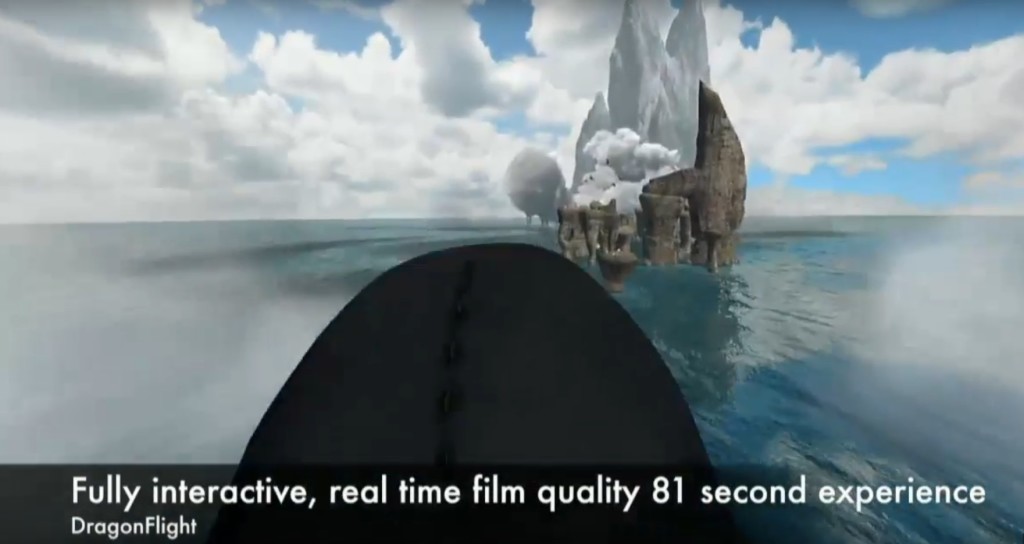SPACES is an independent virtual- and mixed-reality company founded by members of DreamLab, a creative division of DreamWorks Animation. After three years of creating solutions in the rising world of virtual and mixed reality, the team received DreamWorks’ blessing and became its own company. Shiraz Akmal, CEO and co-founder of SPACES shared his insight into the lessons learned and his advice for creating or expanding your brand within this new medium.
“Over those three years,” Akmal said, “In all the dozens and dozens of different hardware we got to touch, we were busy working, and building, and trying to figure out how we actually leverage VR in a way to tell our stories to leverage the technology in a way that can bring new experiences to our fans and audiences around the world.”
Look Around The Mountain
“One of the important things we realized early on when we found ourselves talking about VR was the idea that it’s three-dimensional. This is a really important thing, especially for those of you who haven’t had a chance to try it or build a project. But if you think about VR, we kind of think about it as a space. Our definition is, it’s a unit of virtual or mixed reality. A space is a unit of virtual or mixed reality. The idea of a space is the building block for VR. Design spaces rather than pages.”
Akmal compares the challenge of designing for virtual reality to a scene in the film, Close Encounters of the Third Kind. After a group of people each expressed their vision of Devil’s Tower through art, climbing it in real life proved to be a challenge. While most of their group failed to imagine the mountain outside of their flat drawings, Roy was able to see the best route because he had sculpted it in three dimensions. “Maybe you should try sculpting,” Roy famously suggests.
“What we thought about a lot at DreamWorks, and what we think about at SPACES, is the idea that you need to look around the mountain, because that’s the first step in designing for VR.” explained Akmal.
Design Spaces, Not Pages
Theme parks are designed in a way that they encourage certain behavior, and Akmal stresses the importance of mapping your virtual reality space in a similar fashion. He compares a creative space to the layout of Disneyland, which was meticulously designed to direct visitors along paths—interacting with characters, visiting attractions and ultimately ending up at the central castle.
“Virtual reality is kind of a fun thing,” he said. “The simple definition we like to say is, ‘it can take you anywhere’ and part of that is a challenge of figuring out where you start. With the myriad of choices and decisions, we think it’s important, at least for 2016 and on, to think about a publishing strategy, if you will. Part of that strategy is deciding what you’re going to make.”
For the DreamLab team at DreamWorks, one such publishing strategy was a virtual reality app that allowed users to interact with upcoming trailers in a unique way. One scenario allowed people to watch trailers alongside the Madagascar penguins, who will turn to look at you and wave if you face them individually. Internal studies showed that 7 out of 10 people waved back, which was an important realization for the team when designing VR experiences.
Location-based VR Brings Marketing Campaigns To The Audience
To promote the launch of DreamWorks’ How To Train Your Dragon 2, DreamLab designed a location-based virtual reality experience in which users could actually fly on a dragon for 81 seconds. The attraction was made to look like a viking ship and in itself, made an instant photo opportunity. The DragonFlight simulator was a big hit at movie premieres and conventions around the country, attracting over 14,000 flight sessions since 2014.

Although virtual reality may be popular in Seattle or Los Angeles, Akmal reminds us that bringing your marketing campaign to the rest of the country without regular exposure to VR is vital to your strategy.
Utilize Social Media Influencers To Spread Awareness
Although the DreamLab team initially decided never to release video of the DragonFlight simulator, they found that social media influencers were an efficient and amusing way to spread the word. During his presentation, Akmal showed a video clip in which a young YouTube influencer named Josh Carlon took DragonFlight for a spin, much to the entertainment of his followers.
Your Best Partners Are Your Competition
“For content creators and brands, one of the best partners you have today, especially over the next few years really, are the hardware manufacturers, who have every interest in promoting your content in order to help sell the hardware itself.”
DreamWorks partnered with Gear VR for its hardware launch in a mutually beneficial strategy to promote the hardware and Kung Fu Panda 3. As a result, the large television ad campaign marketed for both companies simultaneously.
Although partnering with hardware manufacturers may seem obvious, seeing other content creators as allies may not come naturally. Since the audience for VR and mixed reality is still growing, Akmal recommends reaching out to other software manufacturers as peers and not seeing them as competition. “Today we look at all our partners and allies in the VR space as partners rather than competitors, because there’s so much more that has to be done to create an audience and a market.”
Push Yourself To See What’s Possible
Mixed reality has the power to bring anything into a space, and Akmal is especially excited about a recent partnership with Blue Bubble’s My Singing Monsters game. Also called augmented reality, this form of combining real and virtual elements is a new and promising way to reach audiences.
“What’s real exciting is pushing yourselves from a creative perspective to see what’s possible,” Akmal concluded. “I’m really excited to be at the forefront along with any of you in figuring that out.”

